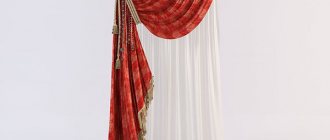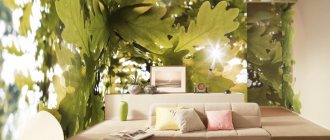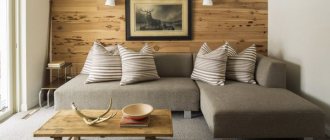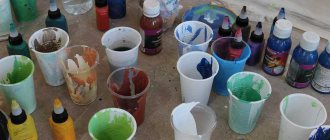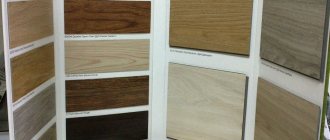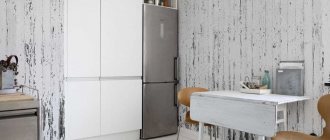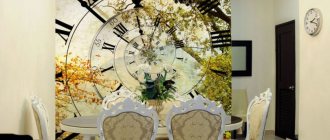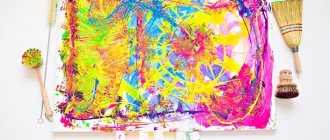The use of fabric in interior decoration is a fairly ancient design technique. The rooms decorated in this way were distinguished not only by their beauty. They looked luxurious and solemn thanks to the use of materials such as silk, velvet, and brocade. This design was available only to royalty.
Modern fabrics can also add solemnity or coziness to a home, depending on the wishes of its owner. By draping the walls with various fabrics, you can complement the overall style of the room or add a unique accent.
Canopy with drapery over the bed in the bedroom
Draping the walls with beige fabric
The wedding hall is extremely popular. It is fashionable, beautiful, creates the effect of sophistication and nobility. The use of velvet and velor is appropriate here. They will give the interior a luxurious look.
The picture of the holiday is complemented by the wedding table and the wall behind the bride and groom. Pastel colors, airy fabrics falling in soft folds, an abundance of bows, flounces, and chiffon flowers will emphasize the splendor of the festive celebration.
It’s not easy to think through and decorate the hall for a wedding on your own. In this case, the best option would be to turn to the services of professional designers.
Draping the walls with white fabric
No. 1. Advantages and disadvantages of wall decoration with fabric
The steadily growing popularity of wall decoration with fabric is explained by a number of advantages of such decor:
- aesthetics and excellent appearance with a huge variety of possible colors and patterns - this is the main advantage of such finishing;
- additional heat and sound insulation of the room;
- natural fabric is a breathable material, therefore it will allow you to maintain an optimal microclimate in the room;
- in this way you can disguise minor imperfections in the walls;
- the fabric is elastic, so shrinkage will not be a problem;
- no waste during finishing;
- if the fabric is wide, then the number of seams will be minimal.
The fabric also has significant disadvantages:
- the material is capable of absorbing odors, so it is better to use such finishing as far as possible from the kitchen;
- the fabric attracts dust, so it will need regular care;
- Installing fabric yourself is somewhat more difficult than installing wallpaper, although the process cannot be called too complicated.
Modern manufacturers offer fabrics that are treated with special compounds, so they absorb less moisture, do not fade, do not attract dust, and can even withstand the effects of moisture, so the disadvantages of such finishing are gradually reduced to a minimum.
Interior decoration with fabric upholstery instead of wallpaper on the walls: relevance in the interior
Page navigation
Using fabric to decorate the walls instead of the usual wallpaper will give the room a special shine and novelty. Many leading interior designers believe that paper wallpaper is a thing of the past, and the future of design art lies in fabric finishing. Its relevance is obvious:
- chic appearance;
- such repairs can be done with your own hands;
- not typical and novel design.
You can use any type of material: from thin linen to thick velvet, from the simplest textiles to expensive silk.
No. 2. What fabric is best to choose for walls?
Almost any fabric can be used for wall decoration:
- natural. Jacquard, brocade, and linen are often used; cotton, silk, and satin are less commonly used;
- artificial. The most striking example is viscose;
- synthetic: polyester, polyamide, polypropylene.
Of course, synthetic and artificial fabrics behave much better in use, they do not wrinkle, do not accumulate static electricity, do not attract dust as much, and almost do not fade, but they are not natural. The best option is mixed fabrics , made partly from natural fibers and partly from synthetic ones, which allows them to perform wonderfully in use and remain breathable.
It is better to purchase fabric that has undergone special treatment to be more resistant to sunlight, dust, and moisture.
It is better to choose a design so that it does not tire or irritate your eyesight with its diversity. Some fabrics have a foam backing, which gives them improved strength characteristics.
Features and Specifications
Some features and characteristics of textile wallpaper:
- In terms of size, the roll can have a standard width from 0.53 to 1.2 m or be seamless, with dimensions of 3 m in width and up to 50 m in length.
- The service life of these fabric products is 10 years, models made from natural materials can last from 5 to 7 years.
- Models made of artificial fabric, polyester or jute are most often used for painting.
- When purchasing fabric wallpaper, you need to pay attention to the symbols on the roll.
No. 3. Where is the best place to use fabric trim?
Considering the properties of the fabric, it cannot be called a universal finish for any room. This material is best used in areas such as:
- bedrooms;
- living rooms;
- offices.
Kitchens, hallways, children's rooms - all these are rooms where the walls often get dirty, and since cleaning the material is a very complex and time-consuming process, it is better to refrain from this type of decoration. However, fabric is often used to decorate walls in restaurants.
What to consider when choosing textile decor
After studying all the advantages of textile decoration of wall surfaces, we can testify that the fabric is not too capricious for interior decoration.
Before starting the work process, it is recommended to consider several important nuances:
- The temperature in the room in which the drapery will be carried out should not fall below 20 degrees. The humidity level inside the space should be less than 80%;
- The amount of consumables should be selected taking into account the condition of the wall surface. When purchasing, it is recommended to take into account differences in the plane and level differences. Thanks to the surplus, it will be possible to quickly and timely correct minor defects;
Experts recommend not making joints in the seam area. It is best to measure the width of the canvas, which will fill most of the surface.
No. 4. Fabric fastening methods
Today, several methods of decorating walls with fabric are used. The main ones:
- Pasting is the most common option, which is somewhat reminiscent of installing wallpaper, so the area of the room is not reduced. In this case, it is better to use light fabrics (muslin or tulle, for example), so the surface of the walls should be level and smooth.
- upholstery _ This method requires the construction of a frame, so the space of the room will be reduced by several centimeters, and additional materials will be required, but the main surface practically does not need to be prepared for finishing, and the wires can be safely placed behind the fabric;
- drapery. In this case, the textiles will resemble the curtains we are used to, only they will cover not a window, but a blank wall or partition. Cornices can be either decorative or hidden. Sometimes, instead of hidden curtain rods, adhesive tape is used, which subsequently simplifies the process of washing the fabric. In this way, you can make both light draperies and lush multi-tiered ones, and even decorate walls according to the principle of Japanese curtains, so this finishing option is perfect for any type of interior;
- finishing part of the wall, niche, creating an applique. In this case, the fabric can be attached using one of the methods listed above, but only on part of the wall. This decoration looks impressive above the head of the bed, especially when the same fabric is used for both the walls and the curtains. In this way, you can zone the space of the room and emphasize interesting elements, for example, niches.
Drapery – elegant walls of banquet halls
Decoration with soft cascading waves is used in halls for celebrations and banquets, in living rooms, and in preparation for a holiday. The photo shows fabric decor, which can be replaced quickly, step by step repeating simple steps with ready-made material. The fabric must be prepared:
The advantage of this method is that you can quickly cover the walls and give the room a decorative and festive look. Then, in a short time, change the style and theme, decorate the room for the next celebration. The trim does not need to be glued; it is enough to temporarily hang soft draping material.
The advantage of drapery is the ability to quickly change the design, wash the fabric, use any finishing option in turn, inexpensively creating a stylish and elegant look. This option was not suitable for Kirill and me, since we are doing major renovations of residential buildings and apartments.
No. 5. How to cover walls with fabric?
Of course, the process of installing fabric on walls is not the easiest and cannot be done alone, but with the right level of care, covering walls with fabric is not so difficult. The main thing is to follow simple tips:
- It’s better to choose the widest possible fabric ; ideally, the width of the roll should be greater than the height of the room - then the finish will be completely seamless. If the width is not enough, then you need to sew several pieces of fabric in advance to get a fabric of the required size;
- important attention should be paid to the preparation of the walls : they must be smooth, even and dry;
- if the material shrinks slightly , then simply iron it, but if the shrinkage is strong, then, first of all, it needs to be wetted, dried and ironed, and only then can you start stitching the fabrics;
- Glue the finished canvas only along the edges , apply the glue to the wall. It’s easier to start from the far left side, the width of the glue strip is about 10 cm. If the fabric is heavy, then it is better to use additional temporary fastening - wooden slats;
- Next, glue the top edge of the fabric and wait until the glue is completely dry so that you can properly stretch the fabric and glue it first on the right side, and then on the bottom;
- it is better to take fabric with a reserve , and after installation, the excess parts can simply be trimmed;
- You can start gluing from the top , then attach the fabric to the sides, and then from the bottom.
Air bubbles may form along the edges where the fabric was glued to the wall the next day. In this case, it is enough to just make punctures and iron them.
After installing and drying the fabric, the wall can be decorated with skirting boards, moldings, baguettes - it’s a matter of taste and the chosen interior style.
Covering on and under the rail
Next in line was the bedroom. We used a seamless method by attaching viscose fabric wallpaper to the walls under the strip. The width of the panel made it possible to cover the entire wall. I prepared the fabric and, with the help of my nephew, rolled it up. Then we followed the instructions.
Installing a wooden plank
The procedure can be seen in the video.
To cover the slats, you can glue a fabric border, glue moldings on it, or decorate it with braid, lace, or paint. The finishing idea can be any. The main thing is to do it carefully and in accordance with the style of the interior. In place of the socket and switch, I cut the fabric, made a hole with an allowance of 2 cm on one side and secured it around the perimeter with the same strip as the entire panel. The office needed silence to work, so the fabric was attached to a rail and a thin layer of foam rubber was laid.
You can pre-glue frames from slats to size and cover them with fabric. The insulating backing is inserted into the frames. The covering is done invisibly with nails on the reverse side. The finished sections are mounted on the walls using glue. All that remains is to mask the joints of the frames.
Advice! The frame covering method is convenient if you often need to replace the cladding with another one. Or update in places where the surface is quickly wiped and smeared, for example, in hallways and corridors.
No. 6. How to upholster walls with fabric?
Upholstering or even covering the walls with fabric will require the construction of a frame, which can be made of wood, plastic or even rubber strips. Typically, wooden planks are used, and the installation process looks like this:
- you need to prepare wooden planks of the required length , 10 mm thick and 50-70 mm wide;
- first, all horizontal strips are attached : under the ceiling, above the floor, above door and window openings;
- then vertical strips are mounted , starting from the corner in increments of 0.5-0.6 m;
- you need to start attaching the ironed fabric from the corner near the ceiling ; for fastening, use a stapler or nails, the distance between which should be 5-10 cm;
- the fabric is stretched with great effort , the verticality of the panel is checked with a plumb line, and care must be taken that folds do not form on the fabric;
- fabric allowances after installation are tucked under the wooden planks with a screwdriver.
Instead of wooden planks, you can use a ready-made polyvinyl chloride profile, thanks to which you can get the most bizarre shapes, however, it is quite expensive and is used for fastening polyester.
General recommendations for interior stylistic solutions
It is possible to decorate walls with textiles:
- Partially, when natural or synthetic materials are used to finish individual parts. So for decorating only the wall near the bed or fireplace or mirrors.
- Completely, at the same time, a combination of fabrics belonging to the same color scheme can add sophistication, or, on the contrary, the combination of materials can be based on the contrast of shades or patterns.
- Textile elements cut out using a stencil, for example, rhombuses, ovals. This will add zest and originality to the interior.
Individual elements of the canvas can be glued to the prepared surface, or stretched onto the frame.
No. 7. How else can you attach fabric to the wall?
Not so often, but still used is the method of fastening fabric with nails . In this case, the material is simply nailed to the wall - easily and reliably. You can use tar nails along the edges, and with decorative caps in the center.
Draping walls with fabric is done in the simplest possible way. In this case, it is enough to glue the tape with loops to the wall, and sew the second part of the tape with hooks to the canvas. Thus, you can get any draperies and the most interesting effects. Moreover, the fabric can be removed and washed at any moment.
Material selection
The best solution for decorating walls with fabric in residential premises is to choose special fabrics designed specifically for mounting as decoration. They are completely safe (painted with harmless paints), retain their brightness well for a long time, but are very expensive. Inexpensive options include furniture fabrics (jacquard, tapestry). The dense weave of the fabrics ensures lightness while maintaining integrity. Such fabrics fade slowly. An additional advantage is the creation of good sound insulation in the rooms. It is acceptable to use natural fabrics with a less dense weave and, accordingly, less wear resistance (linen, cotton and sisal in their pure form or with a small percentage of viscose). The use of such materials allows you to create a special coziness and guarantees environmentally friendly finishing of the premises. Light and translucent fabrics (taffeta, cambric) are least often used for interior decoration. They are suitable for decorating individual sections of walls.
No. 8. Manufacturers of fabrics for wall decoration
Of course, no one forbids using absolutely any fabric for wall decoration, but to get the highest quality results, it is better to use fabrics from the most famous manufacturers, among which it is worth highlighting:
- Bekaert Textiles is a Belgian textile manufacturer. Its fabrics for wall decoration require a minimum of care, are distinguished by a dense weave and the presence of a Teflon coating, which makes the surface as resistant to mechanical damage as possible. The manufacturer claims that its fabrics are resistant to high humidity and can even be used in bathrooms. The range of designs and patterns is more than decent;
- Creation Baumann - Swiss-made fabrics that are distinguished by increased durability and a variety of different shades and patterns, there is even fabric with a starry sky effect;
- Sangiorgio is a famous Italian company producing jacquard fabrics. The production has been operating for more than 40 years, and all this time the traditions and principles have remained unchanged: the highest quality and constant expansion of the range. Wall fabrics are presented in several collections, so finding the most suitable canvas for the design is not so difficult;
- Lesura is a French-made fabric that is made from cotton, polyester and foam or cotton and viscose. The rolls have a width of 2.6-2.95 m, so in the vast majority of rooms the covering can be installed seamlessly. All fabrics in the range have an anti-dust and anti-stain coating and do not fade in the sun, so the company is not afraid to give a 10-year guarantee on its products. The assortment includes 21 textures and 170 colors;
- Clara Lander is a French fabric manufacturer that has been on the market since 1981. Today, its products are used by designers around the world to furnish homes, offices, hotels, restaurants and television studios. The range of colors is impressive: from plain canvases in soothing shades to fabrics that imitate the colors of animal skins. All the company’s fabrics have antistatic properties, are waterproof, and are treated with anti-mold and antibacterial compounds. Stains from the surface are easily removed; standard and fire-retardant products are available for sale. It is better to attach these fabrics to the wall using a frame;
- Bruvatex is a well-known Belgian manufacturer of quality fabrics for wall decoration. Fabrics 2.8 m wide are made from cotton or a mixture of cotton and viscose; all fabrics are treated with antistatic and anti-fading compounds, so their service life is quite long. They are attached to the wall using a profile and come in a variety of colors and designs to suit every taste. Stains from such a coating can be easily removed - the main thing is not to leave them to dry.
If you take fabric from a reliable and reputable manufacturer, then all the disadvantages of decorating walls with fabric can be minimized, enjoying only the numerous advantages.
The article was written for the site.
Tags:Wallpaper, Wall panels
What is fabric wallpaper?
Fabric wallpaper is a roll material for interior decoration, which includes several layers. The front side of such a canvas is a fabric, such as linen, polyester, jute or cotton. The composition of textile wallpaper may include paper, non-woven materials or non-woven materials. Previously, such products were called damask and decorated the walls of houses during the Empire, Baroque and Classicism.
Creative panel made from patches
Any housewife will have colorful scraps of fabric in her house that don’t have to be thrown away. You can create a chic panel from multi-colored textiles, especially if we are talking about fans of abstraction. By tinkering a little with the scraps, you can get an original composition, which will later become the pride of the owner of the house.
For the process of making a patchwork panel you will need:
- several scraps of fabric in contrasting shades;
- thick cardboard for the base;
- wooden frame (you can make it yourself from slats);
- threads and sewing machine;
- fabric glue.
All the work will not take much of your time and consists of the following steps:
1. Initially, a schematic picture is formed, then blanks are selected. To avoid confusion, it is better to number them according to the diagram. The resulting composition can be transferred directly to cardboard.
2. Blanks are cut out from the scraps and begin to be placed according to the diagram. To do this, each piece of fabric must be folded in half so that the cut part is not visible on the other side of the future picture, and placed on top of the previous ones.
3. To achieve the required brightness and implement an interesting solution, you need to take a responsible approach to the selection of colors. The shade of the base must be in full accordance with the theme and style of the interior.
4. To fix the patches, you can use either the standard method - sewing on a machine, or use glue designed for working with textiles.
5. The finished composition just needs to be inserted into the frame. You can make several such decorations from scraps, then you will get a modular panel on the wall.
As you can see, making a panel with your own hands is quite simple. This entertainment can also be done for families. This is especially true for children. When working with children, do not forget to control their actions, since scissors are used in the process, and the child may get hurt.
Different techniques for creating paintings from scraps (3 videos)
Beautiful textile panels (45 photos)
Care and cleaning
Care instructions:
- To remove fresh stains and dirt, you can use a soap solution or absorb it with a cloth.
- Dust from the surface of the canvas should be removed using a vacuum cleaner.
- If after gluing there are glue stains left on the front side of the product, they can be removed using a damp sponge using vertical movements.
- Old or fairly strong stains can only be removed by re-sticking the problem area.
Color spectrum
The color scheme allows you to create a certain atmosphere in the room and set its mood.
Beige
Brings tenderness, coziness and comfort to the room. Such a laconic design will undoubtedly add noble charm and a little rigor to the atmosphere.
The photo shows a textile wall covering made of jute in a bedroom interior.
Green
Organic green allows you to create a favorable atmosphere in the room, giving it its own character and maximum positive emotions.
The photo shows a bedroom and green textile wallpaper with birds.
Red
A multifaceted and rich color that has a special charm and can radically change the design of the entire room. Red textiles make the interior respectable, sophisticated and unique.
Black
It favorably emphasizes the style of the room and creates original and unusual contrasting accents in it. Black color brings special mystery and mysticism to the atmosphere.
White
Neutral white allows you to create unique and inimitable design compositions, and thereby add real interior chic to the room.
Grey
It fits harmoniously into any design, creates a calm atmosphere in it, and due to the quality of the shadow creates interesting illusions of volume on a plane.
Violet
Expressive purple always looks very sophisticated, extravagant and noble, and is an indicator of good taste.
How to stick
Pasting vinyl stickers is not difficult, but you must follow certain rules. Firstly, the room must be warm. Temperature not lower than +15°C. Secondly, humidity is normal, walls or any other surface must be dry and clean. There should be no dust, no grease, no dirt. If possible, the area under the sticker should be treated with a degreaser (solvent).
How to apply vinyl stickers to a wall - step by step photos
To work, you will need a small plastic spatula, which can be successfully replaced with an old plastic bank card. If you don't like working with plastic, try a dry, clean, soft cloth. These devices will help expel air bubbles from under the film.
We glue a large picture from vinyl film
The area for work has been prepared, the next procedure is as follows:
- Let's take the sticker apart and see how it will look. Very often it is a set of fragments. We take fragments and assemble them into a picture. We fasten them with pins or stationery tape in the intended place. Let's go away and take a look. If you are happy with everything, let's start gluing.
- You should start from the bottom and move up.
First, the central fragment is glued, and the others are joined to it. So it turns out that you will have to move in two directions - from bottom to top and from the center to the edges. At first it’s not clear what and how - From the bottom of the fragment we peel off a small section of the backing that protects the adhesive layer.
Apply to the work surface. We try to glue it evenly, but if it doesn’t work, it’s okay - peel it off and try again. After the “start” has been glued correctly, we take plastic or a rag. Peel it off, folding a small part of the protective paper and gluing the strip. Peel off the protective paper again and stick it on. Moving up and to the sides we glue the entire fragment. When sticking, do not remove the protective film from the front part - We looked, the fragment was glued evenly, everything was fine. Remove the protective film from the front part.
- We repeat the operation with the next piece of the picture. But now we still need to join the parts. The slightest discrepancy will be visible, so don't rush. We glued it, checked it, and removed the protective layer from the front part.
- We glue all the parts in the same way.
That's all. A few notes on the process
It is important to try to expel the air from under the vinyl film. Therefore, we move slowly, avoiding omissions
Then there will be no bubbles. If the peel-off backing is in the way, it can be cut off.
We remove the film that is pasted on the front side after the fragment is completely pasted and all the air is removed. At the same time, you cannot leave it on the part when the next one is glued - the seam will be visible.
Features of a small picture
Above we described the process of gluing a large picture, consisting of several pieces that need to be joined to each other. But such complications are not always necessary. Some images are a set of elements that can be arranged relative to each other in any order. Such elements are usually glued on one sheet. They just need to be removed from the backing and pasted on the wall.
It’s easier to glue small fragments: popular butterflies and cartoon characters (Kitty)
But even in this case, in order not to make a mistake and not to re-glue the fragments from place to place, cut them out together with the backing. It is not necessary to strictly follow the contour; you can capture free areas of the substrate. Now distribute these pieces over the surface as you imagine, using pieces of masking tape. Evaluate the result. You may have to move something somewhere, change places. When you are satisfied with the result, start gluing.
Which styles are best to use?
This type of finish can be used in the following style solutions.
Classical
Textile products will harmoniously complement the concept of a classic interior and add special luxury and sophistication to it. A floral print, strict or symmetrical geometry will match the general mood of this style.
Eastern (Chinese and Japanese)
Plain textile wallpaper in neutral shades or models with unobtrusive patterns and ornaments will perfectly highlight this subtle, sophisticated and harmonious style. Jute products with companion wallpaper will add color and a touch of exoticism to the oriental interior.
The photo shows jute wall covering in an oriental style bedroom.
English
Fabric canvases are the main element in the design of the English style. They favorably complement the aristocracy and nobility of this style solution and give the interior coziness and warmth.
Modern
Laconic and discreet textile products in light and light colors fit perfectly into a modern and stylish design.
Provence
Decoration in the Provence style involves warm colors, floral patterns with ornate weaves that will successfully fit into a room imbued with French charm.
